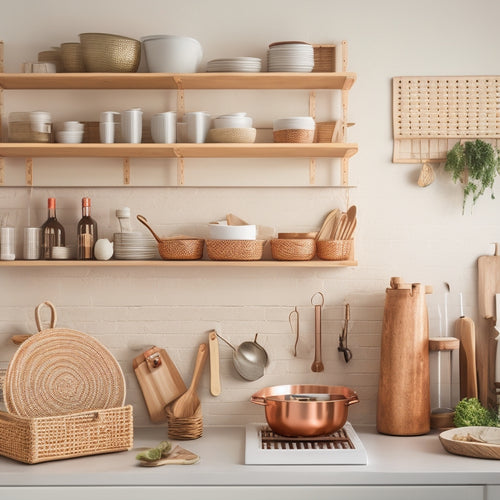
Why Cluttered Kitchens Trigger Anxiety and How
Share
As you step into a cluttered kitchen, you're instantly hit with feelings of anxiety and overwhelm. It's no surprise, considering the visual chaos and sense of disorganization that surrounds you. The good news is that you can break free from this cycle of stress by tackling the clutter head-on. Start by purging unwanted items, assigning a home for essentials, and optimizing storage and layout. Next, establish a cleaning routine that works for you, and commit to maintaining your newly organized space. By doing so, you'll be amazed at how a clutter-free kitchen can transform your cooking experience - and your mental well-being.
Key Takeaways
• Cluttered kitchens trigger anxiety by visually overwhelming the senses, making it difficult to focus and relax.
• A disorganized kitchen can lead to feelings of guilt and shame, contributing to increased anxiety levels.
• Clutter can impede workflow, causing frustration and stress when searching for misplaced items or cooking in a chaotic environment.
• A clutter-free kitchen, on the other hand, can promote a sense of control and calmness, reducing anxiety and stress.
• By implementing organization strategies, such as categorizing, assigning homes, and establishing cleaning routines, individuals can reduce kitchen clutter and alleviate anxiety.
Purge Unwanted Kitchen Items
Start by gathering three boxes or bins labeled 'keep,' 'donate/sell,' and 'recycle/toss' to help you categorize and eliminate unwanted kitchen items that contribute to clutter and anxiety. This simple step will get you started on the path to a more organized kitchen.
Begin by clearing off countertops and sorting items into their respective bins. Be honest with yourself – when was the last time you used that kitchen gadget or appliance? If it's been over a year, it's likely safe to donate excess items or recycle them.
As you sort, consider the items that can be donated or sold, and set them aside to benefit someone in need or to earn some extra cash. By decluttering countertops, you'll instantly feel a sense of relief and reduction in anxiety.
Assign a Home for Essentials
Now that you've purged your kitchen of unwanted items, it's time to assign a home for the essentials that will help you maintain a clutter-free space. This step is pivotal in keeping your kitchen organized and anxiety-free.
Start by categorizing your essential items into groups, such as baking supplies, cooking utensils, and cleaning products. Once you've grouped your items, assign a specific place for each category. For example, designate a specific drawer or cabinet for your baking supplies. This will help you develop a routine of putting things back in their assigned home after use.
Using organizing techniques such as the 'one in, one out' rule and decluttering tips like keeping frequently used items in easy-to-reach locations will help maintain your kitchen's organization. Labeling each category's assigned home will also help you and others quickly identify where items belong.
Optimize Storage and Layout
You'll maximize your kitchen's functionality by strategically positioning appliances, cabinetry, and countertops to create a seamless workflow. This thoughtful layout will help reduce stress by minimizing the time and effort needed to prepare meals.
To optimize storage, consider a 'golden triangle' layout, where your sink, stove, and refrigerator form the points of a triangle. This design allows you to quickly move between tasks, reducing fatigue and anxiety.
Next, assess your kitchen's storage capacity. Install shelves, hooks, or baskets to keep frequently used items within easy reach. Label each storage space to maintain kitchen organization and avoid clutter buildup. By assigning a designated spot for each item, you'll reduce the likelihood of clutter accumulating in the future.
A well-organized kitchen not only looks more appealing but also helps you stay focused and calm while cooking. By optimizing your kitchen's layout and storage, you'll create a more efficient and peaceful cooking environment, reducing stress and anxiety in the process.
Establish Cleaning Routines
To maintain your newly optimized kitchen layout and storage, set aside time each day to tidy up and establish a regular cleaning routine that fits your lifestyle. This will help you stay on top of clutter and prevent it from building up again.
Start by allocating a specific time slot each day, whether it's 10 minutes in the morning or 30 minutes after dinner, to clean and organize your kitchen.
Effective time management is key to maintaining a clutter-free kitchen. Prioritize tasks based on importance and urgency, and break them down into smaller, manageable chunks.
For instance, you can dedicate Mondays to cleaning the counters, Tuesdays to wiping down appliances, and so on.
Maintain Your New Space
With your kitchen layout and storage optimized, it's essential that you take steps to protect your investment by maintaining your new space. You've worked hard to declutter and organize your kitchen, and now it's time to keep it that way. One of the most effective decluttering tips is to put things back in their designated place after use. This habit will prevent clutter from building up again.
Another organization hack is to schedule regular cleaning sessions, even if it's just 10-15 minutes a day. This will help you stay on top of messes and keep your kitchen sparkling.
To maintain your new space, create a routine that works for you. Set aside time each week to tidy up and restock supplies. You can also implement a 'one in, one out' policy to prevent new items from adding to clutter.
Related Posts
-

Revolutionize Your Kitchen Storage With These Ideas
You're ready to revolutionize your kitchen storage! Start by incorporating ladder-accessible shelves and utilizing cl...
-

Streamlined Kitchen Sink Organization Solution
A streamlined kitchen sink organization solution must balance functionality with aesthetics. A well-designed system s...

